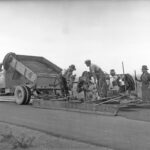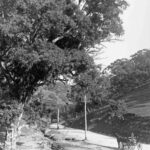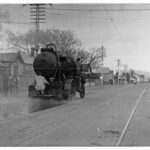Roads are an integral part of daily life. Every time we commute to work or school, go shopping or travel on holidays, at least part of our journey is by road. Most freight is moved by road at some stage. Today all this happens effortlessly and reliably because a superb engineering organisation makes and maintains an efficient road system. But the first settlers in South Australia had no such system and suffered delay, loss and damage. This is the story of how an efficient road system was created.
First Tracks
Before European colonisation, Aboriginal people used a well developed network of tracks to move around the countryside. The first settlers used many of these tracks because they followed the best routes available in the absence of roads made for wheeled vehicles. Farmers moved their wheat from farm to market and miners their ore from mine to port in bullock drays. Drays with their two wheels were highly manoeuvrable and well suited to rough tracks. But the heaviest dray hauled by four or six bullocks carried only about two-and-a-half tons at four miles per hour. Even after the first few log bridges improved a route, travel remained slow and expensive. Travellers and carters sought to minimise the road journey in favour of shipping and railways.
Transportation of ore from the Burra mines, discovered in 1845, needed 600 drays. In winter the drays’ heavy wheels sank into the soft ground and required two extra bullocks to haul a reduced load. To reach Port Adelaide it took teams a three week round trip. When Port Wakefield, opened in 1850, and the railway to Kapunda, opened in 1860, the bullockies quickly chose those shorter routes.
Poor roads were dangerous. In March 1850 driver Harry Rufus was descending Teatree Gully when his dray jolted over a stump; he fell from his dray and was killed when the wheel passed over his head. Flood waters were especially dangerous. In 1862 Derby Whelan was drowned in Kent Town when the bridge he was standing on disintegrated, and in June 1852 four lives were lost when the mail coach was swept away while fording the River Light near Kapunda.
Roads and tracks carried the colony’s produce, and until the introduction of the electric telegraph in 1857 provided the fastest means of communication. As farm and mine production increased during the 1840s, colonists demanded better transport. Horses were faster and stronger than bullocks, and larger four-wheel wagons carried more than drays. But horses and waggons needed better roads.
The Great Eastern Road
Requests for a road with easy gradients and a smooth hard surface prompted Governor George Gawler to commence the Great Eastern Road in 1840. Construction through the Glen Osmond Gorge was at government expense. Facing financial difficulties, his successor Governor George Grey enacted the first road legislation. This threw the cost onto Trustees who could charge tolls. But the cost of collection left little for the road’s ongoing maintenance, and there were protests that it was inequitable to toll travellers only on this road. The toll was abolished in 1847.
The road opened up the fertile Mount Barker district for development which further increased traffic. Over the next 160 years a succession of seven improved alignments illustrate the ongoing nexus between better roads and development.
Early Road Authorities
Other roads in the colony were made at government expense by the Colonial Engineer as funds and labour permitted. In 1849, in preparation for self government, the colonial government established roads boards to make and maintain main roads and district roads. Board members were elected by citizens and their fortnightly meetings were open to the public and reported in the press. The public often attended to lobby for their projects.
The boards appointed ‘surveyors’ (engineers) to plan and supervise road construction and maintenance. Construction work, especially large projects, was usually undertaken by contract. Road and bridge contracts played an important part in developing local engineering expertise. Maintenance work was carried out by ‘day men’ (labourers employed by the boards), or under small contracts awarded to local farmers and agricultural workers. Since macadam pavements deteriorate rapidly, there was plenty of work and it was an important source of employment between busy periods on farms.
From 1853 local government bodies with additional powers and elected by local citizens, replaced district roads boards. In 1865 and again in 1875 the government established extra regional roads boards to ensure road funds were spent equitably between regions.
Early Road Funding
Initially road funds were raised by a tax on vehicles, the ‘odious dray tax’. Dray owners had no representation on the roads boards. They rallied against the tax under the cry ‘no taxation without representation’. The tax was quickly withdrawn. The boards’ funds were then voted by the colonial government from general revenue. Although the boards had power to levy tolls, they only once used this power – the heavily trafficked Port Road from 1867 to 1870. Councils raised funds by imposing rates on residents. They also received grants for road work from the colonial government.
The initial cost of road construction was low in comparison to the high ongoing cost of maintenance. So loan funds, heavily used to fund capital intensive railway construction, were sparingly used to fund road construction.
For the period 1849 to 1889 road expenditure averaged a fairly constant ₤1/10 ($3.00) per capita, indexed to 1936 values. In response to public disquiet about deteriorating road conditions, the government occasionally voted short term increases peaking in 1850, 1857, 1867 and 1879 at ₤2/10 ($5.00).
Road Improvements
With adequate allocations of funding after the mid 1850s, many roads still in use today were set out, cleared and formed.
More durable masonry arch bridges and sophisticated long span laminated timber arch bridges replaced the earlier rudimentary log bridges. From the 1870s, the increased availability and affordability of wrought iron made durable long span bridges possible. Longer spans enabled bridges to be raised clear of most floods and traffic experienced less disruption.
Macadam pavements provided a hard, durable and relatively smooth road surface to ease travel. Macadam comprised a layer of egg-sized hard stones, known as ‘metal’. Road making was a seasonal activity, with rock quarried in winter then carted to site in summer when the roads were dry and hard. It was stacked in heaps on the road side to be broken by hand with knapping and spalling hammers into egg-sized stones. This work, regarded as easy, was sometimes awarded to women, the elderly and even children. The broken stone was then spread in winter and ‘blinded’ by sweeping the surface with fine sand. Winter rain and traffic then bound the metal and fines into a solid pavement.
Road works were usually on a small scale because traffic was seldom large enough to justify extensive work. Since the major source of power in the 19th century was muscle – animal or human – large scale projects were only possible with large workforces, larger than road funds usually permitted.
The opening of a new road or bridge was an important local celebration, marked by an official ceremony and luncheon. By April 1864 road improvements allowed Charles Dinham to start a twice weekly ‘First Class Omnibus’ service to Cape Jervis. The 67 mile trip had been reduced to only one day.
Competition between communities for road funding was intense. Residents knew poor roads impeded the development of a locality by causing damage to vehicles and their loads, delaying traffic and even costing lives. Mr Cobbledick, a fruit grower in the Adelaide Hills, complained in January 1872 that his late season apricots had been destroyed by the bad road by the time he reached Adelaide. Residents at Templars in 1879 petitioned for a new bridge as ‘children were compelled to sit all day in wet clothes’.
Roads in Decline
By 1887 the roads boards had constructed 4000 miles of main roads of which 2000 were metalled. The government had also constructed 1600 miles of railways and a large number of ports around the coast. Shipping and railways offered easier and cheaper transport than roads which now fed traffic to the nearest jetties and railways. Roads importance as transport arteries declined. The colonial government abolished its roads boards and handed responsibility for main roads to local councils. It established a small Roads Department to administer main roads grants to councils.
However, in 1889 severe floods destroyed many roads and bridges. Against its wishes the government again found itself engaged in road making. But despite this, between 1890 and 1923. government road funding fell to its lowest level at ₤1/5($2.50) per capita.
Effective control of road works passed from the elected roads boards to un-elected bureaucrats, overseen by a responsible government minister answerable to Parliament. Ironically this transfer happened just as roads were once again to become important transport arteries.
Re-Emergence of Roads
During the 1890s bicycles had introduced the concept of easy personal mobility free from the expense and inconvenience of keeping a horse. In 1900 the first petrol-driven motor car spluttered onto a South Australian road. Motor vehicles revolutionised South Australian transport. Cars provided rapid and easy mobility, while motor lorries hauled great loads and buses carried many passengers at speed.
Between 1919 (the earliest surviving records) and 1929 the number of registered motor vehicles almost quintupled from 17 525 to 85 472. To cater for the greatly increased traffic, the state government introduced motor vehicle taxation in 1916 to help fund road reconstruction. In 1923 the Federal government became the third level of government to fund roads and expenditure quickly grew. Finally, in 1926 the government created a Highways Fund under the sole control of a Highways Commissioner into which vehicle tax was deposited.
Changes in Road Transport
Motor vehicles replaced horse-drawn traffic, which dwindled from 27% of vehicles in 1924 to 6% in 1928. The South Australian Government regulate motor traffic: speed limits from 1904, registration from 1906, and tyre weight limits, originally set in 1867, were revised in 1923.
At first the introduction of motor vehicles halved the rate of road fatalities. In 1896 there were 71 road related fatalities in South Australia, 20 per 100 000 population, mainly due to injuries inflicted by horses. In 1921, the first year statistics were collected, there were 48 road deaths, 10 per 100 000. Only 7 of these were attributed to motor vehicles. But by 1928 there were 86 motor vehicle related deaths in a total of 112, 20 per 100 000. The death rate peaked in 1970 at 30 per 100 000. Changes such as compulsory wearing of seat belts, random breath testing, driver education and improved roads and vehicles have now reduced this rate to around 8 per 100 000.
Later Road Improvements
Heavier, faster and more numerous motor vehicles destroyed roads built for light, slow-moving, animal-drawn traffic. Water bound macadam pavements disintegrated as fast vehicles sucked out the fine blinding material, which became a cloud of dust obscuring the road. Motorists demanded dust-free, all-weather surfaces and roads. During the 1920s and 1930s roads were straightened and widened, strengthened and re-surfaced with bituminous concrete (asphalt) or spray seals to make them dust and weather-proof.
The great power of the internal combustion engine which had revolutionised road transport, was now applied to road making equipment. Excavators and trucks made possible the large scale earthworks needed by straighter and wider roads. Mechanical crushers produced material which was spread and compacted by motorised graders and rollers to provide stronger and smoother pavements. Mechanical plants produced the bituminous concrete (asphalt) placed by mechanical pavers, and mechanised sprayers and spreaders sprayed hot bitumen onto the gravel surface then spread gravel chips for a cheaper spray seal.
Line-marking along the centreline, made possible by permanent bituminous surfaces, fences at dangerous corners and white marker posts along the edge delineated roads for the motorist speeding along. Electric street lighting and vehicle headlights aided nocturnal travel.
All these improvements made road transport much safer and more attractive.
Dominance of Road Transport
Road transport now competed favourably with rail and shipping in speed, cost and convenience No longer did travellers seek to minimise their road journey. To protect both the new road surfaces and its railways, the government introduced transport control in 1930. But despite this, the advantages of road transport ensured its dominance. The face of South Australia changed. Regional building materials and styles, and regional factories and breweries disappeared as bricks and beer from the city were trucked to the country. The speed and comfort of motor cars encouraged rural people to travel further to larger regional centres; small towns, coastal shipping and rail services withered. Large suburban shopping centres surrounded by large car parks replaced local strip shops, drive-in theatres replaced suburban picture theatres, and housing expanded into car-dependent ever more distant suburbs. City commuters moved from trams and trains into their own cars to face peak-hour traffic congestion.
Need for Traffic Management
City roads filled with traffic and had to be duplicated. Traffic at intersections had to be managed by traffic lights. The first traffic lights were installed along Adelaide’s King William Street in 1937, with the first suburban lights a decade later at the intersection of South and Henley Beach roads. In the country, major roads were duplicated and towns bypassed.
In the 1960s the Metropolitan Area Transport Study recommended a $500 million program of freeway construction to cope with Adelaide’s increasing traffic; the scale of proposed acquisitions caused such an outcry that most of the plan was shelved. Instead, the introduction of clearways in the 1970s and the computerised phase-linking of traffic lights during the 1980s eased urban traffic congestion. Increasingly, intelligent transport systems responding instantly to changed traffic conditions, now manage traffic. The Heysen tunnels on the South-Eastern Freeway are monitored and speed limits can be changed to ensure safety, and the reversible Southern Expressway is also monitored.








Comments
3 responses to “Roads”
I am looking for any information including photos of the METS PROJECT plan for Adelaide’s roads
Hi Adrian,
That’s not something we have any files on. The best place to start enquiries is probably State Records of South Australia – https://www.archives.sa.gov.au/
Hi,
Can anyone one please tell me when traffic lights were installed in Whyalla SA including location – it would be much appreciated